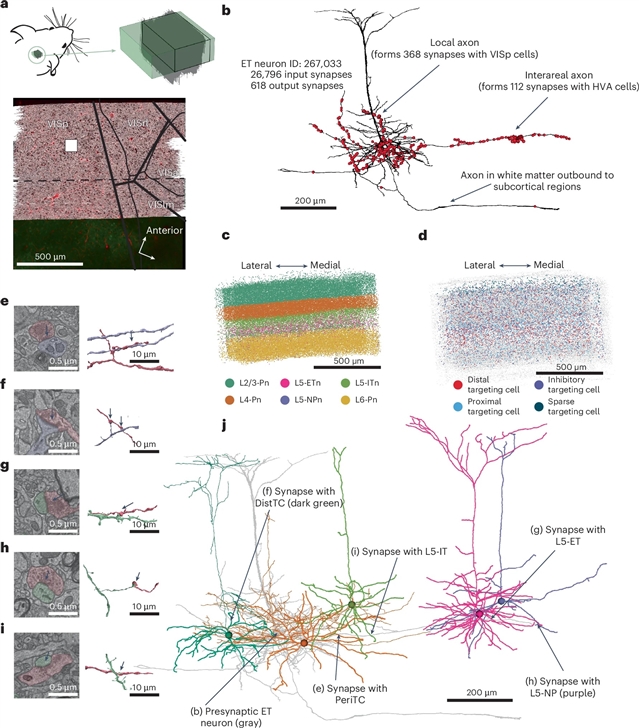
美国艾伦脑科学研究所Nuno Maçarico da Costa课题组的一项最新研究开发出了小鼠视觉皮层第5层厚丛状兴奋性神经元的突触结构。2025年7月28日出版的《自然—神经科学》发表了这项成果。
尽管在表征新皮质细胞类型方面取得了重大进展,但对单个兴奋性细胞的突触连接的完整理解仍然是未知的。本研究探讨了无主题视觉皮层厚簇状第5层锥体细胞的连通性,也称为脑外神经元(L5-ETns),主题为1Mm3公开提供的电子显微镜数据集。分析表明,在L5-ETns的邻近区域,L5-ETns主要与一组抑制性细胞类型建立联系,而抑制性细胞类型反过来又专门针对L5-ETns。
L5-ETns最常见的兴奋靶点是第5层脑间神经元(L5-ITns)和第6层锥体细胞,而与其他L5-ETns的突触则不太常见。当L5-ETns将轴突延伸到其他皮质区域时,它们倾向于更多地与兴奋性细胞连接。他们的结果强调了一个电路基序,其中兴奋性细胞亚类与特定抑制细胞类型形成亚回路。这是一种公开可用的、自动化的突触识别和自动细胞分型方法,为探索其他神经元类型的连通性提供了一个框架。
附:英文原文
Title: The synaptic architecture of layer 5 thick tufted excitatory neurons in mouse visual cortex
Author: Bodor, Agnes L., Schneider-Mizell, Casey M., Zhang, Chi, Elabbady, Leila, Mallen, Alex, Bergeson, Andi, Brittain, Derrick, Buchanan, JoAnn, Bumbarger, Daniel J., Dalley, Rachel, Gamlin, Clare, Joyce, Emily, Kapner, Daniel, Kinn, Sam, Mahalingam, Gayathri, Seshamani, Sharmishtaa, Suckow, Shelby, Takeno, Marc, Torres, Russel, Yin, Wenjing, Bae, J. Alexander, Castro, Manuel A., Dorkenwald, Sven, Halageri, Akhilesh, Jia, Zhen, Jordan, Chris, Kemnitz, Nico, Lee, Kisuk, Li, Kai, Lu, Ran, Macrina, Thomas, Mitchell, Eric, Mondal, Shanka Subhra, Mu, Shang, Nehoran, Barak, Popovych, Sergiy, Silversmith, William, Turner, Nicholas L., Yu, Szi-chieh, Wong, William, Wu, Jingpeng, Celii, Brendan, Campagnola, Luke, Seeman, Stephanie C., Jarsky, Tim, Ren, Naixin, Arkhipov, Anton, Reimer, Jacob, Seung, H. Sebastian, Reid, R. Clay, Collman, Forrest, da Costa, Nuno Maarico
Issue&Volume: 2025-07-28
Abstract: Despite significant progress in characterizing neocortical cell types, a complete understanding of the synaptic connections of individual excitatory cells remains elusive. This study investigates the connectivity of mouse visual cortex thick tufted layer 5 pyramidal cells, also known as extratelencephalic neurons (L5-ETns), using a 1mm3 publicly available electron microscopy dataset. The analysis reveals that, in their immediate vicinity, L5-ETns primarily establish connections with a group of inhibitory cell types, which, in turn, specifically target the L5-ETns back. The most common excitatory targets of L5-ETns are layer 5 intertelencephalic neurons (L5-ITns) and layer 6 (L6) pyramidal cells, whereas synapses with other L5-ETns are less common. When L5-ETns extend their axons to other cortical regions, they tend to connect more with excitatory cells. Our results highlight a circuit motif where a subclass of excitatory cells forms a subcircuit with specific inhibitory cell types. This is achieved using a publicly available, automated approach for synapse recognition and automated cell typing, offering a framework for exploring the connectivity of other neuron types.
DOI: 10.1038/s41593-025-02004-2
Source: https://www.nature.com/articles/s41593-025-02004-2
Nature Neuroscience:《自然—神经科学》,创刊于1998年。隶属于施普林格·自然出版集团,最新IF:28.771
官方网址:https://www.nature.com/neuro/
投稿链接:https://mts-nn.nature.com/cgi-bin/main.plex
